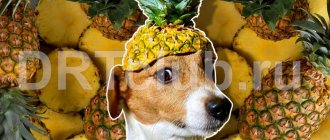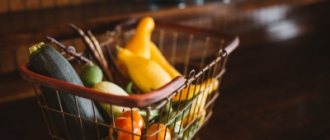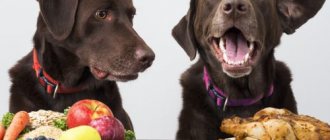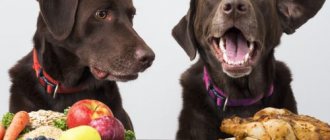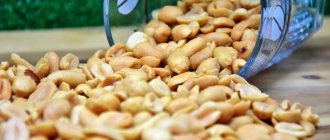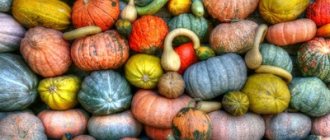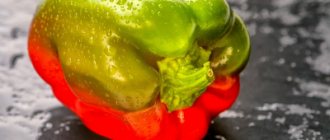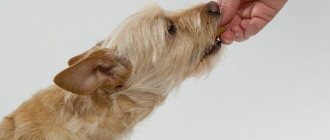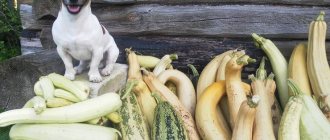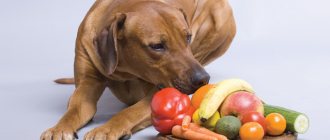When getting a dog, responsible owners ask themselves the question: how to properly structure its diet? It is no secret that both the health and longevity of an animal depend on proper nutrition.
To do this, the dog must receive all the necessary vitamins and microelements. In humans, the concept of “healthy, proper nutrition” is not complete without fruits. But whether dogs need fruit is a big question. We will discuss the answer to this in the article.
List of useful
Fruits should occupy a small part of the diet. They do not need to be given every day and not all of them. The following will be beneficial for your dog:
Apples
In our latitudes, this is the most common and appropriate treat for your pet. They contain vitamins A and C and are a valuable source of fiber. Good for digestion. At the same time, the content of proteins and fats in the fruit is low, so it can be treated to older dogs without fear.
Another advantage of apples is that they rarely cause allergies. And thanks to the large number of varieties, you can choose exactly the taste that your pet likes: sweet, sour, sweet and sour.
Pears
Not very sweet and ripe fruits are useful. Another inexpensive, like an apple, and healthy fruit. It is characterized by a high content of fiber, vitamins C and K, and the microelement copper.
Veterinarians say that regular consumption of pears reduces the risk of a heart attack in an animal by about half. They also rarely cause allergies, and dogs usually enjoy crunching on pears. Almost like a bone, only sweet!
Plums
Unlike apples and pears, they should be given with caution: overripe plums cause stomach and mental upsets in dogs (due to the alkaloids they contain). But a small amount of unripe seedless fruits will help diversify your diet.
Papaya
An exotic fruit that is difficult to imagine in a dog’s diet. But in vain: it is very useful. Papaya has the property of improving digestion and eliminating problems with the gastrointestinal tract. In veterinary pharmacies you can find tablets with papaya extract.
Important : when feeding this fruit, you must take precautions!
- Choose ripe fruits without any foreign smell or waxy coating. It is worth making sure that the papaya has passed a health inspection.
- You can feed your pet small, peeled pieces. In large quantities, the fruit can cause an increase in blood sugar and cause constipation.
Watermelons
In the summer, this huge berry will perfectly complement the drinker: it contains up to 92% water. There are also vitamins A, C, B and B-6, potassium. If the watermelon is homemade, guaranteed without nitrates, then it can be given with rinds (but without seeds).
Bananas
They are a stumbling block: some dog breeders claim that bananas are not allowed for animals, while others freely feed them to both adults and puppies.
Bananas are high in potassium, copper, fiber and vitamins, so they can be given periodically. But not in large quantities and unripe: the abundance of sugar makes a banana a harmful, but welcome treat for a dog.
Melon
A safe, but absolutely devoid of nutrients, treat. Melon is a great way to quench thirst in the summer, and to make it more healthy, you can mix the melon pulp with a spoonful of honey (if the dog is not allergic to it). In large quantities it can cause a laxative effect.
Persimmon
There are enough useful elements in persimmon (vitamins C, PP, E, A and trace elements: calcium, potassium, iron, phosphorus, manganese, magnesium, iodine, copper), and all dogs without exception like it.
But don’t get carried away: it causes stomach upset. This property can also be used for benefit by feeding persimmon to your pet if there are problems with stool.
We recommend that you read separate articles about mango and pineapple for dogs.
Which ones are not allowed?
You need to give your pet any unusual fruit carefully, a little at a time, so that if something happens, you can immediately identify and stop an allergic reaction. But there are a number of fruits that are definitely prohibited: they cause eating disorders, allergies, and irritate the mucous membranes.
Important : even if dog owners write on forums that their animal “eats it without any problems,” you should not experiment with your pet’s health. A particular example only shows that someone got a dog with excellent health, or the animal’s problems went unnoticed.
Forbidden fruits include:
- Citruses. Strong allergen, irritates mucous membranes. Most often, after eating citrus fruits (tangerines, oranges, etc.), dogs begin to vomit and suffer from diarrhea.
- Pomegranate . For humans, this fruit is considered healthy, but for dogs it will only cause stomach problems: it is too sour. Bones cause digestive problems and can be toxic to small breeds.
- Peaches. They also cause diarrhea, lead to the accumulation of cyanide in the body, and their seeds can be deadly poisonous.
- Quince. Toxic to dogs: causes profuse vomiting and swallowing problems. It is also very sour - and not every person will agree to eat it.
- Avocado. Contains a substance that has a “stunning” effect for animals. It simultaneously provokes vomiting, diarrhea, breathing and heart problems, and pancreatitis.
Important : jam, even from permitted fruits, is contraindicated for dogs - due to the high sugar content and lack of benefit.
How many times a day should you feed your dog?
While the puppy was still small, we had to feed him literally by the hour. But already at the age of one year, the diet is divided into one or two feedings. Some owners prefer to feed in the morning and evening, while others feed only before bed. Veterinarians consider both options acceptable, although the first is still better.
Important! A sick or old dog should be fed light, low-fat food, dividing the usual diet into 3-4 meals for better digestion.
If the animal is not prescribed a different regime, then the question “feed the dog before or after a walk” should not be relevant at all. And this is not a matter of habit of the dog or the owner - doctors are unanimous on this matter - you can give your pet food only after a walk, and not vice versa. The fact is that a dog’s gastrointestinal tract is designed in such a way that when overfilled with food during active movement, it can twist, forming a volvulus of the stomach and part of the intestines. Therefore, first an active walk, and then food.
If there is a need to feed the animal before walking (it cannot recover normally without replenishing its stomach with food), then the walk in this case should take place in an inactive form, only to relieve its natural needs. Only after an hour will the dog be allowed to frolic to his heart's content.
Important! In winter, when it is cold, the amount and calorie content of food for the dog kept in the enclosure should be increased.
Small breeds
Small breeds require special treatment: various poisons and allergens affect them much more strongly. If a huge Alabai calmly swallows a couple of unhealthy pieces of fruit and ends up with an upset stomach, then the Chihuahua can be seriously poisoned, even fatally.
Therefore, you should choose 100% safe fruits for them, feed them in small pieces and avoid getting crusts and seeds. Let’s stipulate: a “small piece” for a dog weighing 1.5-2 kilograms is a piece the size of half a finger.
There is an opinion that only apples are allowed for small dogs. In any case, “controversial” fruits like bananas or plums should not be included in their diet.
Large
First of all, don’t forget to give your large dog fruit from time to time, based on his “fierce appearance.” She is, of course, a predator, but she also needs vitamins. It is optimal that fruits occupy 15% of the diet - that is, one fruit can be given every day (if the animal is more than 10 kilograms, otherwise half is enough).
Large dogs are allowed to be given a banana once a week, a whole apple – 2-3 times a week. You don't have to cut the apples: they will train your jaws and help clean your teeth of plaque.
How to give?
Firstly, precautions. New fruits should be given in small quantities, not exceeding 1 tsp. After the treat, you should wait a day. If itching, nervousness and other strange symptoms do not appear, the dose is increased 2-3 times. Another day has passed and no problems have appeared? Great, the animal can continue to feed the fruit.
There are a number of rules for feeding fruit:
- Fruits must be washed. Most (except apples and pears) are peeled.
- Bones should not be given under any circumstances.
- The treat is cut into small pieces.
- It is useful to mix fruits with cottage cheese and grated vegetables. But with fermented milk products - you can’t.
- If the dog refuses to eat the fruit, rub it into the porridge. But if the trick didn’t help, you shouldn’t force it.
Some may find it strange to give your pet fruit like this, “on a plate,” peeled and washed. But this will help keep him healthy.
Rules for feeding plant foods
We described above what vegetables and fruits a dog can eat. Now let's look at the rules for eating plant fruits:
- New foods unknown to your pet should be introduced gradually and little by little. It is enough to give one teaspoon of a new treat once a day.
- If any allergic symptoms occur, you should immediately discard the product. And for a couple of days, give only proven food.
- Vegetables should be heat treated before consumption.
- Vegetables can be fed to pets in stewed, boiled, steamed, raw form, depending on the product, see above.
- Cook and simmer foods for 20 minutes without salt.
- You can prepare a salad of several vegetables using flaxseed oil.
- You cannot force it; some dogs are not attracted to vegetables and fruits at all.
Could you be allergic to them?
Food allergies to fruits in dogs are common. It is difficult to guess what it will manifest itself into; you will have to act by trial and error. If the animal begins to itch, rashes appear on the skin, the nose, eyes, and tips of the paws turn red - this is an allergy. Need to:
- Give an antihistamine.
- Reduce feeding to neutral, already proven feeding.
- Show it to a veterinarian to clarify the diagnosis.
An allergic reaction can be persistent, lasting 2-3 days. All this time the dog needs a diet.
What to do if things get bad?
Vomiting and weakness after eating fruit can be associated with two things:
- The pet ate something forbidden.
- The fruit turned out to be of poor quality (lots of nitrates, overripe, treated with pesticides).
In this situation, you need to provide the dog with access to fresh air and drinking water. Induce vomiting if the pet cannot do this on its own, then give activated carbon based on the dog’s weight. And be sure to show the animal to a veterinarian.
What are the harms of bananas for your pet?
Any product consumed in excess is harmful to the body. Frequently eating fruit in excess portions leads to constipation, food begins to be poorly digested, and intestinal obstruction occurs. Due to the presence of sugars, you cannot feed your pet fruits every day; it is worth responsibly organizing the feeding of overweight or sedentary dogs.
Individual intolerance can be expressed:
- allergic reaction;
- hyperarousal or lethargy;
- change in weight;
- gastrointestinal disorder.
Overripe fruits with dark areas sharply change the acidity level, causing fermentation in the intestines, bloating, and increased gas formation in dogs. Spoiled products can cause poisoning - vomiting, diarrhea, painful spasms. It is dangerous to give unpeeled fruits; the dog can be poisoned by toxic substances applied to banana plants.
In case of poisoning, the pet's stomach is washed, for this purpose a weak solution of potassium permanganate is diluted or a soda-salt mixture is used (a small spoon of soda in a glass of water), after which the animal is given activated carbon or another absorbent, and free access to drink is provided, if the disturbing symptoms do not stop, then it is necessary Visit a veterinary clinic immediately.
In practice, much depends on the characteristics of a particular organism; before introducing a new food into your pet’s diet, it is advisable to consult a veterinarian.
Are they necessary?
You can and should give fruit to your pet. They are an irreplaceable source of fiber, vitamins and glucose, so they should be included in the diet, especially if the dog is fed natural food. Besides, it’s simply delicious: you don’t refuse treats, do you?
There is an objection that in nature dogs do not eat fruit; their stomachs are accustomed exclusively to meat. But this is not so: firstly, nothing prevents an animal in the wild from picking up fruits, especially since dogs are not so much descendants of predators as of omnivorous scavengers.
Secondly, four-legged pets live next to humans for thousands of years. And during this time they adapted to human habits and food.
Why do dogs need vegetables and fruits?
The main diet of a four-legged pet includes about 5% products of plant origin, 70-80% meat and dairy products, and the rest - various cereals.
Fruits and vegetables are, first of all, suppliers of fiber, which is not digested by the dog’s body, but at the same time has a beneficial effect on the functioning of the gastrointestinal tract. At an early age, fruit and vegetable dishes will add vitamins and help in the formation of a healthy intestinal environment. In adulthood, plant foods will relieve your pet of excess cholesterol and replenish the supply of essential microelements, as well as improve stool.
